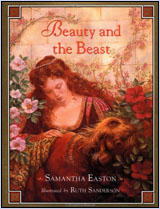Werewolves, lycanthropes, and theriomorphs (the politically correct term of the 1990s for animal people, shown of its horrific baggage) are essentially shapeshifters. Contrary to current pop-cultural beliefs (codified by screenwriter Curt Siodmak's invented lore for the 1941 Universal classic The Wolf Man), shapeshifters of ancient myth, folklore, and "real life" have always been capable of changing at will. They also transform completely into their animal form, rather than the half-animal, half-human menagerie of popular horror literature, pulp fiction, horror comics, television, cartoons, and movies, which tend to literalize the Anglo-Saxon roots of the term werewolf, which indeed means "man-wolf".
 Beings much like them - talking wolves and manlike beasts - frequently
appeared in folk tales, Mother Goose rhymes, and
the classical fairy tales transcribed by the Brothers Grimm and Charles Perrault, including popular fixtures like
"Little Red Riding Hood" and "Beauty and the Beast."
Beings much like them - talking wolves and manlike beasts - frequently
appeared in folk tales, Mother Goose rhymes, and
the classical fairy tales transcribed by the Brothers Grimm and Charles Perrault, including popular fixtures like
"Little Red Riding Hood" and "Beauty and the Beast."
In addition to mythology and legends, however, scholars, historians, and folklorists have gathered supposedly true tales of shapeshifters and werewolves for centuries. Among the most distinguished of these studies are Sabine Baring-Gould's The Book of Werewolves (1865), Elliot O'Donnell's Werewolves (1912), and Frank Hamel's Human Animals, Werewolves, and Other Transformations (1915), which covers all imaginable variations on worldwide beliefs in shapeshifters and animal-people. Famed occult researcher Reverend Montague Summers's exhaustive tome The Werewolf (1933) remains the definitive text, while Robert Eisler's Man into Wolf (1947) offered the first comprehensive modern antropological and psychological study of the subject.
Lycanthropy is a term commonly used in two different ways, to refer to humans who actually after their flesh-and-blood forms into those of animals (or vice versa), and also to describe humans who, through some psychological disorder, actually believe themselves to be animals.
Primal beings - beast-people who are not associated with shapeshifting or lycanthropy - have other forms, associations, and origins throughout history. Tales of ancient races, often tied to lost worlds like Atlantis and Mu or mythical "hollow earth" realms beneath our feet, were often populated by subhuman, amphibious, or bestial races. With few exceptions, these were never shapeshifters; their subhuman appearance and behavior was immutable, characteristic of their race or species. We will touch on a few of these revelant to lycanthropy, while steering clear of revived prehistoric men and the legendary Yeti and Sasquatch "missing links", as those are seen as human or animal, rather than both - the essential element of those creatures discussed herein.
 With the publication of Charles Darwin's groundbreaking scientific thesis
The Origin of Species (1859) and successors like
The Descent of Man (1871), primal took on other connotations, firmly rooted in Darwin's theories about man's
prehistoric origins. Thereafter, man's bestial side was more often associated with apes that wolves in all except supernatural
fiction and the most superstitious cultures. The Victorian era's shocked reaction to Darwin's theories - to this day, the
theory of evolution is branded as heresy by many Christian factions - means there were still elements of the devil and the taint
of evil associated with Darwinian primals in popular belief and pop culture. The emergin sciences of psychology, psychiatry, and
psychoanalysis also had an impact.
With the publication of Charles Darwin's groundbreaking scientific thesis
The Origin of Species (1859) and successors like
The Descent of Man (1871), primal took on other connotations, firmly rooted in Darwin's theories about man's
prehistoric origins. Thereafter, man's bestial side was more often associated with apes that wolves in all except supernatural
fiction and the most superstitious cultures. The Victorian era's shocked reaction to Darwin's theories - to this day, the
theory of evolution is branded as heresy by many Christian factions - means there were still elements of the devil and the taint
of evil associated with Darwinian primals in popular belief and pop culture. The emergin sciences of psychology, psychiatry, and
psychoanalysis also had an impact.
The merger of these seemingly opposing perspectives - the supernatural primal of legend and lore, and the new scientific Darwinian and Freudian prototypes - was forged by Robert Louis Stevenson's classic The Strange Case of Dr. Jekyll and Mr. Hyde. As a product of chemistry rooted in lycanthropic lore and a belief in man's simian primal self, Mr. Hyde was arguably the first scientific primal, ushering in a new era of shapeshifters, customized to more contemporary Western cultural beliefs. Though the cause of such throwbacks would vary from story to story - chemistry, surgery, brain or gland transplants, mutation, genetics - as would their nature, with some able to return to human form, whereas others were not - this was a new archetype in the popular imagination.